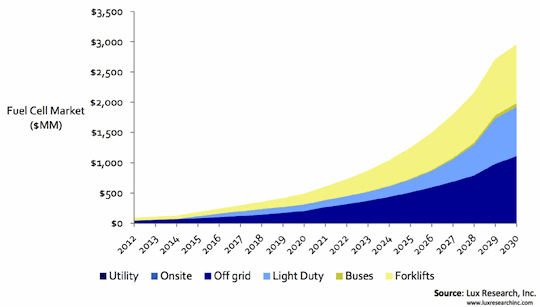Capital cost, not hydrogen supply, will limit adoption to a mere 5.9 GW, dashing dreams of a revolutionary energy future, says Lux Research

As I’ve said for a decade now, hydrogen fuel cells are not going to be a significant, cost-effective CO2 reducer. In a 2005 journal article, “The car and fuel of the future,” I noted that:
Using fuel cell vehicles and hydrogen from zero-carbon sources such as renewable power or nuclear energy has a cost of avoided carbon dioxide of more than $600 a metric ton, which is more than a factor of ten higher than most other strategies being considered today….
A 2013 study by independent research and advisory firm Lux Research finds that despite billions in research and development spent in the past decade, “The dream of a hydrogen economy envisioned for decades by politicians, economists, and environmentalists is no nearer, with hydrogen fuel cells turning a modest $3 billion market of about 5.9 GW in 2030.”
Hydrogen fuel cells won’t be a major contributor to solving the problem of manmade climate change until the market is 100 times larger, which simply won’t happen fast enough to matter to the climate fight, even in the unlikely event they ever become a cost-effective CO2 reducer.
The Lux study, “The Great Compression: The Future of the Hydrogen Economy” (client subs. req’d), finds that “hydrogen demand from fuel cells will total 140 million kg in 2030, a meager 0.56% of global hydrogen demand.” Looks like I’m going to win my big hydrogen bet!
Here’s the rest of the news release from Lux:
Although the cost of hydrogen impacts fuel cell market adoption, hydrogen fuel accounts for only 35% of the total cost of ownership (TCO) for stationary applications and 21% of the TCO for mobile applications, with fuel cell capital costs and membrane replacement costs making up most of the difference.
“The hydrogen supply chain is not the most critical bottleneck for fuel cell adoption,” said Brian Warshay, Research Associate and the lead author of the report titled, “The Great Compression: the Future of the Hydrogen Economy.” “High capital costs and the low costs of incumbents provide a nearly insurmountable barrier to adoption, except in niche applications,” he added. In order to determine the economic viability and potential of an expansive hydrogen economy in the energy sectors, Lux Research conducted a detailed analysis of the costs of hydrogen generation, distribution, storage, and consumption in an effort to find the greatest constraints and opportunities. Among their findings:
- Hydrogen generation accounts for less than 33% of the cost at the pump.The costs of hydrogen compression, storage, and distribution make up the majority of the cost of hydrogen, offering the greatest opportunities for improvement and innovation.
- PEM cells will have a $1 billion stationary market. Proton exchangemembrane (PEM) fuel cells for telecom power and backup will reach $1 billion in 2030, while fuel cells of all types for residential, commercial and utility generation will not prove cost-effective.
- Mobile applications will be worth $2 billion. PEM fuel cells will reach $2 billion on the backs of forklifts and light-duty vehicles, while buses will remain miniscule. A robust hydrogen vehicle fueling infrastructure is necessary but ultimately insufficient to overhaul the passenger vehicle market.
- Hydrogen demand from fuel cells will total 140 million kg in 2030, a meager 0.56% of global merchant hydrogen demand across all industries.
It is long past time to end the hype about hydrogen.










